Auditing Theory and Practice: A Case Study of Satyam India Fraud
VerifiedAdded on 2023/06/13
|12
|2966
|104
AI Summary
This report examines the ethical behavior of the auditor and the managers of Satyam (India) and highlights the failures of management and audit. It also discusses the role of auditors and the audit committee in the Satyam India Fraud case.
Contribute Materials
Your contribution can guide someone’s learning journey. Share your
documents today.

Running head: AUDITING THEORY AND PRACTICE
Auditing Theory and Practice
Name of the Student
Name of the University
Authors Note
Course ID
Auditing Theory and Practice
Name of the Student
Name of the University
Authors Note
Course ID
Secure Best Marks with AI Grader
Need help grading? Try our AI Grader for instant feedback on your assignments.
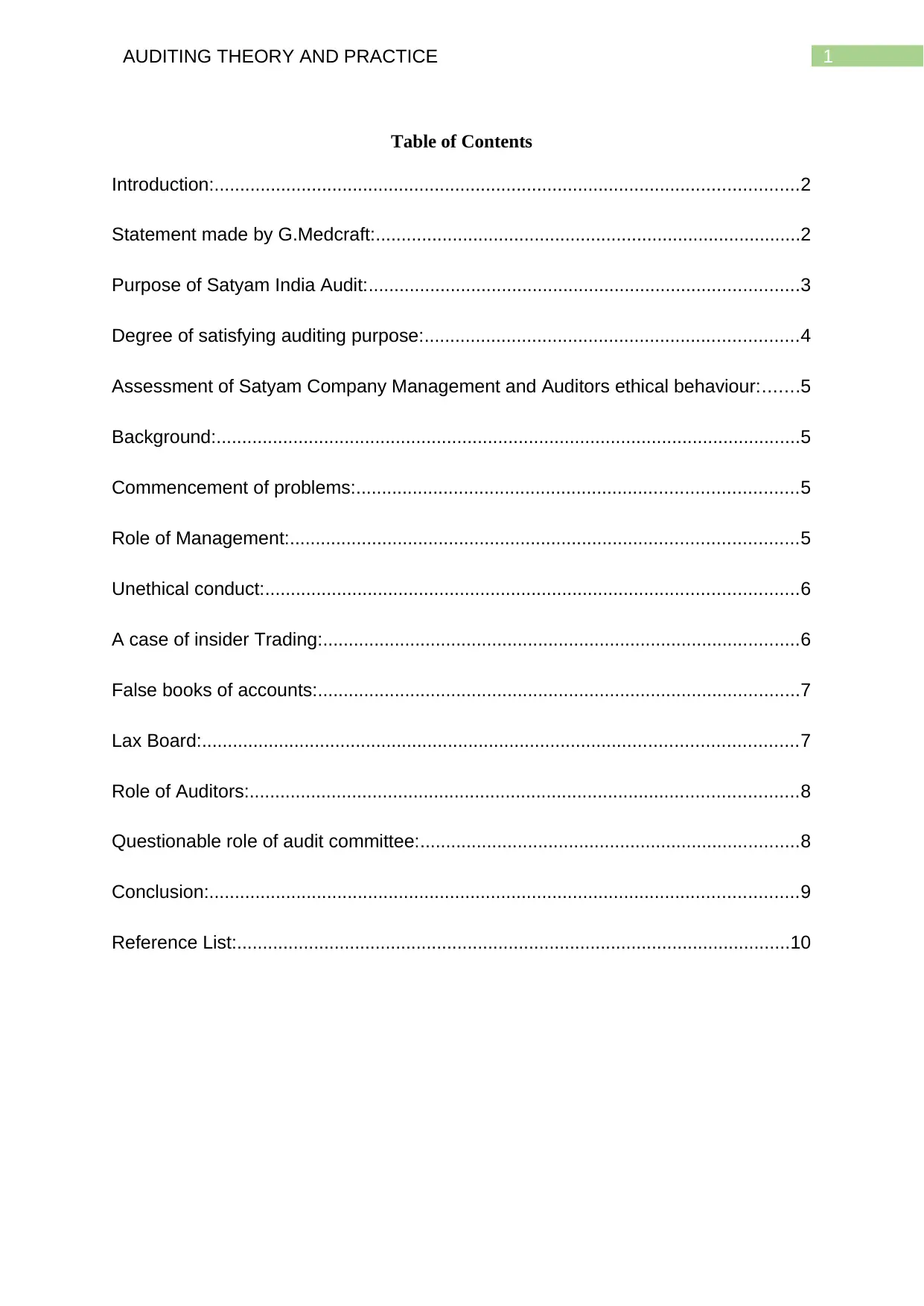
1AUDITING THEORY AND PRACTICE
Table of Contents
Introduction:..................................................................................................................2
Statement made by G.Medcraft:...................................................................................2
Purpose of Satyam India Audit:....................................................................................3
Degree of satisfying auditing purpose:.........................................................................4
Assessment of Satyam Company Management and Auditors ethical behaviour:.......5
Background:..................................................................................................................5
Commencement of problems:......................................................................................5
Role of Management:...................................................................................................5
Unethical conduct:........................................................................................................6
A case of insider Trading:.............................................................................................6
False books of accounts:..............................................................................................7
Lax Board:....................................................................................................................7
Role of Auditors:...........................................................................................................8
Questionable role of audit committee:..........................................................................8
Conclusion:...................................................................................................................9
Reference List:............................................................................................................10
Table of Contents
Introduction:..................................................................................................................2
Statement made by G.Medcraft:...................................................................................2
Purpose of Satyam India Audit:....................................................................................3
Degree of satisfying auditing purpose:.........................................................................4
Assessment of Satyam Company Management and Auditors ethical behaviour:.......5
Background:..................................................................................................................5
Commencement of problems:......................................................................................5
Role of Management:...................................................................................................5
Unethical conduct:........................................................................................................6
A case of insider Trading:.............................................................................................6
False books of accounts:..............................................................................................7
Lax Board:....................................................................................................................7
Role of Auditors:...........................................................................................................8
Questionable role of audit committee:..........................................................................8
Conclusion:...................................................................................................................9
Reference List:............................................................................................................10
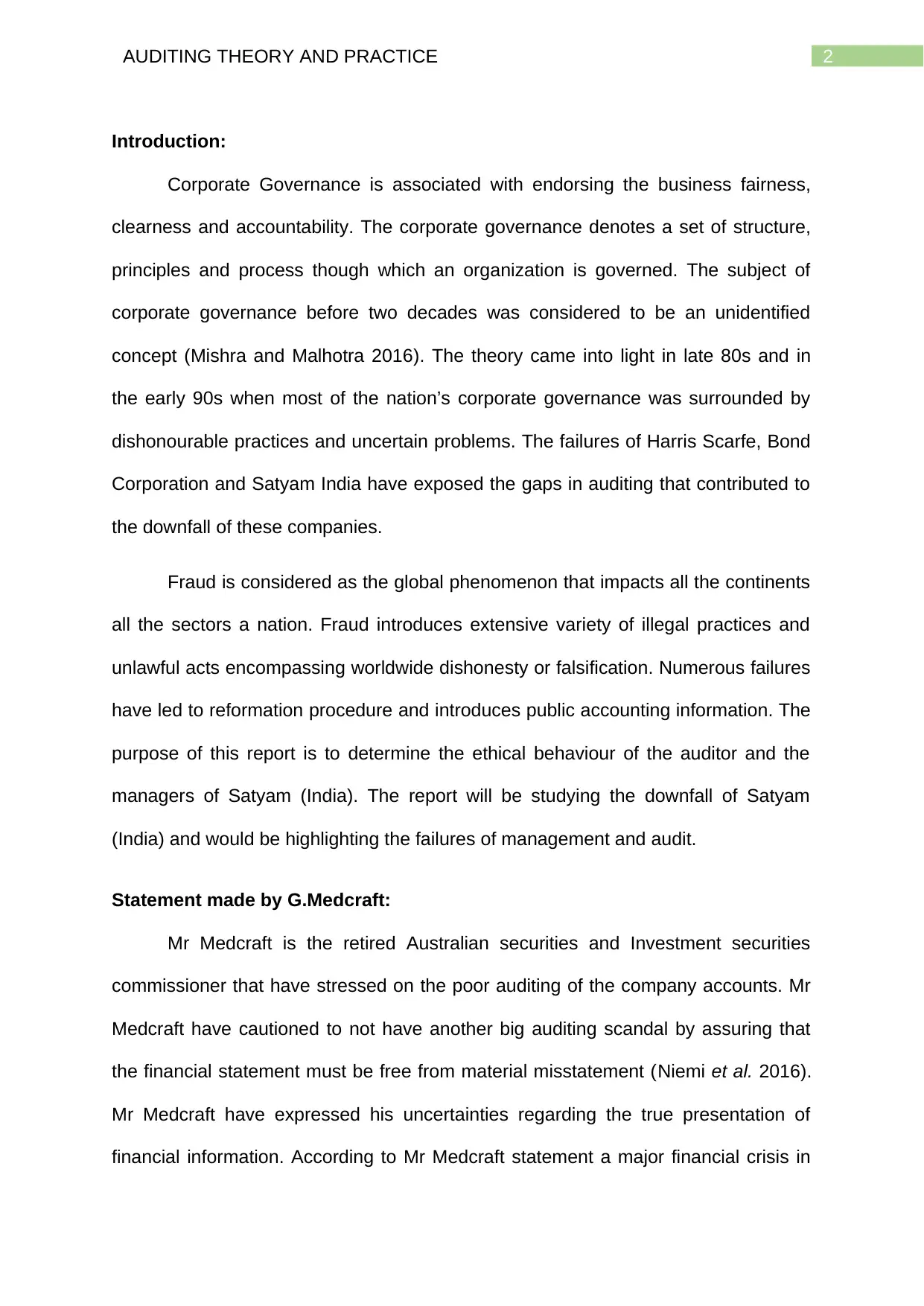
2AUDITING THEORY AND PRACTICE
Introduction:
Corporate Governance is associated with endorsing the business fairness,
clearness and accountability. The corporate governance denotes a set of structure,
principles and process though which an organization is governed. The subject of
corporate governance before two decades was considered to be an unidentified
concept (Mishra and Malhotra 2016). The theory came into light in late 80s and in
the early 90s when most of the nation’s corporate governance was surrounded by
dishonourable practices and uncertain problems. The failures of Harris Scarfe, Bond
Corporation and Satyam India have exposed the gaps in auditing that contributed to
the downfall of these companies.
Fraud is considered as the global phenomenon that impacts all the continents
all the sectors a nation. Fraud introduces extensive variety of illegal practices and
unlawful acts encompassing worldwide dishonesty or falsification. Numerous failures
have led to reformation procedure and introduces public accounting information. The
purpose of this report is to determine the ethical behaviour of the auditor and the
managers of Satyam (India). The report will be studying the downfall of Satyam
(India) and would be highlighting the failures of management and audit.
Statement made by G.Medcraft:
Mr Medcraft is the retired Australian securities and Investment securities
commissioner that have stressed on the poor auditing of the company accounts. Mr
Medcraft have cautioned to not have another big auditing scandal by assuring that
the financial statement must be free from material misstatement (Niemi et al. 2016).
Mr Medcraft have expressed his uncertainties regarding the true presentation of
financial information. According to Mr Medcraft statement a major financial crisis in
Introduction:
Corporate Governance is associated with endorsing the business fairness,
clearness and accountability. The corporate governance denotes a set of structure,
principles and process though which an organization is governed. The subject of
corporate governance before two decades was considered to be an unidentified
concept (Mishra and Malhotra 2016). The theory came into light in late 80s and in
the early 90s when most of the nation’s corporate governance was surrounded by
dishonourable practices and uncertain problems. The failures of Harris Scarfe, Bond
Corporation and Satyam India have exposed the gaps in auditing that contributed to
the downfall of these companies.
Fraud is considered as the global phenomenon that impacts all the continents
all the sectors a nation. Fraud introduces extensive variety of illegal practices and
unlawful acts encompassing worldwide dishonesty or falsification. Numerous failures
have led to reformation procedure and introduces public accounting information. The
purpose of this report is to determine the ethical behaviour of the auditor and the
managers of Satyam (India). The report will be studying the downfall of Satyam
(India) and would be highlighting the failures of management and audit.
Statement made by G.Medcraft:
Mr Medcraft is the retired Australian securities and Investment securities
commissioner that have stressed on the poor auditing of the company accounts. Mr
Medcraft have cautioned to not have another big auditing scandal by assuring that
the financial statement must be free from material misstatement (Niemi et al. 2016).
Mr Medcraft have expressed his uncertainties regarding the true presentation of
financial information. According to Mr Medcraft statement a major financial crisis in

3AUDITING THEORY AND PRACTICE
the areas of audit could be on the horizon if the level of trust is not maintained in the
financial statement. There are instances where the major auditing firms such as
KPMG, PWC, Deloitte and EY have failed to provide reasonable amount of
assurance that the books of accounts are free from material misstatement. Mr
Medcraft has noticed that there was a lack of scepticism and commonly lacked
challenges.
According to Mr Medcraft over the last six years has conducted number of
high intensity surveillance with more than thousands have been investigated and
imprisoned more than 80 people (Davies and Aston 2017). Mr Medcraft has stated
that a tougher actions against the corporate criminals should be imposed along
instead of imposing civil penalties.
In the statement made by Mr Medcraft there is a grave lack of professionalism
and professional scepticism in the roles and responsibilities of the auditors. Mr
Medcraft has stated that Australian companies are required to escape any form of
major auditing scandals which can stain the profession of audit.
Purpose of Satyam India Audit:
An important component of business is audit and Satyam cannot be
considered an exception to this report. The audit report contains the auditor’s opinion
that are related to financial report (Mohapatra, Graham and Nandialath 2015). As a
result of this an organization is obligatory required to follow a certain set of standards
of auditing and process in the preparation of audit report. The primary purpose of
taking the audit report of Satyam is to offer the users of financial report with the
required information relating to a business financial performance.
the areas of audit could be on the horizon if the level of trust is not maintained in the
financial statement. There are instances where the major auditing firms such as
KPMG, PWC, Deloitte and EY have failed to provide reasonable amount of
assurance that the books of accounts are free from material misstatement. Mr
Medcraft has noticed that there was a lack of scepticism and commonly lacked
challenges.
According to Mr Medcraft over the last six years has conducted number of
high intensity surveillance with more than thousands have been investigated and
imprisoned more than 80 people (Davies and Aston 2017). Mr Medcraft has stated
that a tougher actions against the corporate criminals should be imposed along
instead of imposing civil penalties.
In the statement made by Mr Medcraft there is a grave lack of professionalism
and professional scepticism in the roles and responsibilities of the auditors. Mr
Medcraft has stated that Australian companies are required to escape any form of
major auditing scandals which can stain the profession of audit.
Purpose of Satyam India Audit:
An important component of business is audit and Satyam cannot be
considered an exception to this report. The audit report contains the auditor’s opinion
that are related to financial report (Mohapatra, Graham and Nandialath 2015). As a
result of this an organization is obligatory required to follow a certain set of standards
of auditing and process in the preparation of audit report. The primary purpose of
taking the audit report of Satyam is to offer the users of financial report with the
required information relating to a business financial performance.
Secure Best Marks with AI Grader
Need help grading? Try our AI Grader for instant feedback on your assignments.
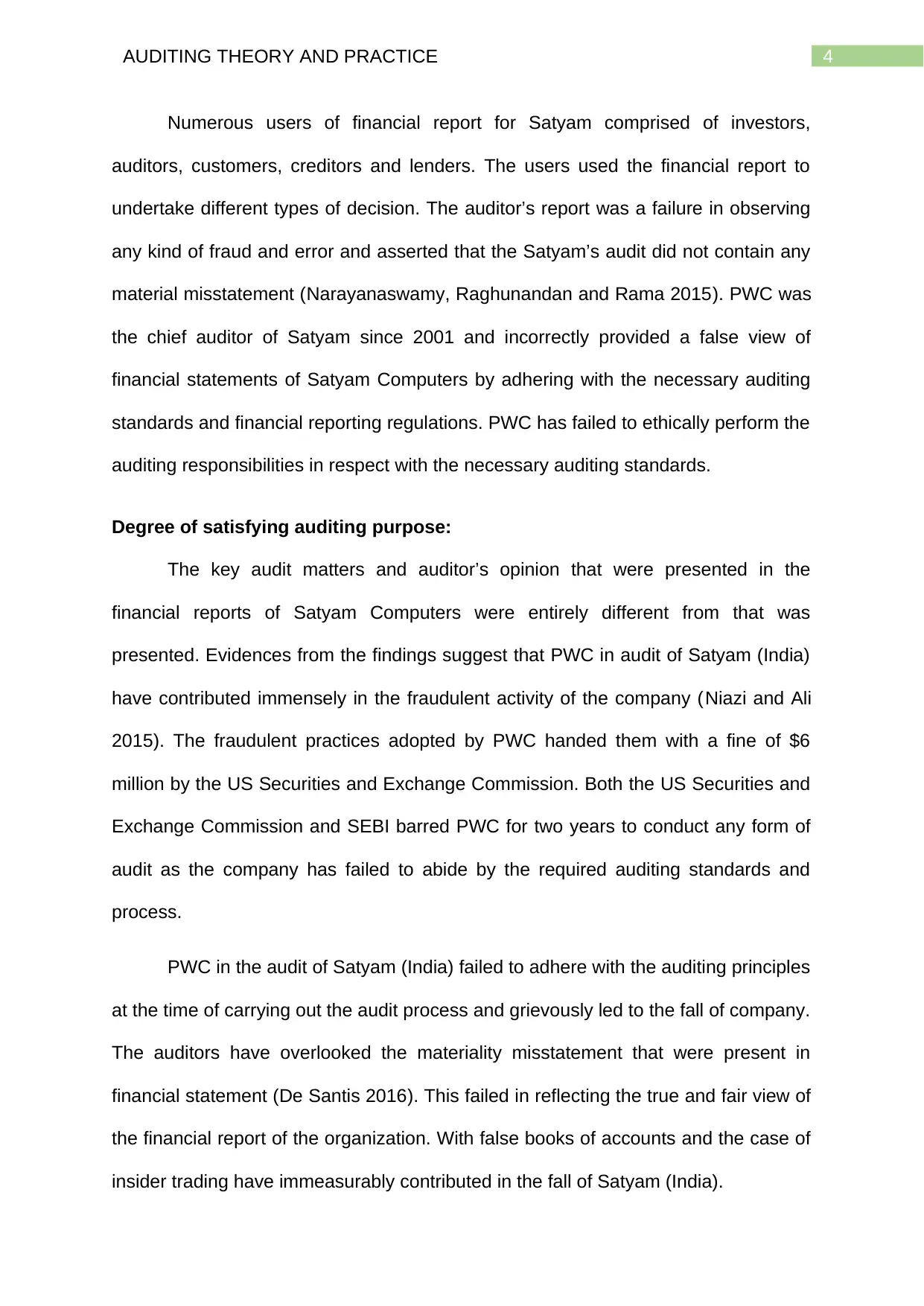
4AUDITING THEORY AND PRACTICE
Numerous users of financial report for Satyam comprised of investors,
auditors, customers, creditors and lenders. The users used the financial report to
undertake different types of decision. The auditor’s report was a failure in observing
any kind of fraud and error and asserted that the Satyam’s audit did not contain any
material misstatement (Narayanaswamy, Raghunandan and Rama 2015). PWC was
the chief auditor of Satyam since 2001 and incorrectly provided a false view of
financial statements of Satyam Computers by adhering with the necessary auditing
standards and financial reporting regulations. PWC has failed to ethically perform the
auditing responsibilities in respect with the necessary auditing standards.
Degree of satisfying auditing purpose:
The key audit matters and auditor’s opinion that were presented in the
financial reports of Satyam Computers were entirely different from that was
presented. Evidences from the findings suggest that PWC in audit of Satyam (India)
have contributed immensely in the fraudulent activity of the company (Niazi and Ali
2015). The fraudulent practices adopted by PWC handed them with a fine of $6
million by the US Securities and Exchange Commission. Both the US Securities and
Exchange Commission and SEBI barred PWC for two years to conduct any form of
audit as the company has failed to abide by the required auditing standards and
process.
PWC in the audit of Satyam (India) failed to adhere with the auditing principles
at the time of carrying out the audit process and grievously led to the fall of company.
The auditors have overlooked the materiality misstatement that were present in
financial statement (De Santis 2016). This failed in reflecting the true and fair view of
the financial report of the organization. With false books of accounts and the case of
insider trading have immeasurably contributed in the fall of Satyam (India).
Numerous users of financial report for Satyam comprised of investors,
auditors, customers, creditors and lenders. The users used the financial report to
undertake different types of decision. The auditor’s report was a failure in observing
any kind of fraud and error and asserted that the Satyam’s audit did not contain any
material misstatement (Narayanaswamy, Raghunandan and Rama 2015). PWC was
the chief auditor of Satyam since 2001 and incorrectly provided a false view of
financial statements of Satyam Computers by adhering with the necessary auditing
standards and financial reporting regulations. PWC has failed to ethically perform the
auditing responsibilities in respect with the necessary auditing standards.
Degree of satisfying auditing purpose:
The key audit matters and auditor’s opinion that were presented in the
financial reports of Satyam Computers were entirely different from that was
presented. Evidences from the findings suggest that PWC in audit of Satyam (India)
have contributed immensely in the fraudulent activity of the company (Niazi and Ali
2015). The fraudulent practices adopted by PWC handed them with a fine of $6
million by the US Securities and Exchange Commission. Both the US Securities and
Exchange Commission and SEBI barred PWC for two years to conduct any form of
audit as the company has failed to abide by the required auditing standards and
process.
PWC in the audit of Satyam (India) failed to adhere with the auditing principles
at the time of carrying out the audit process and grievously led to the fall of company.
The auditors have overlooked the materiality misstatement that were present in
financial statement (De Santis 2016). This failed in reflecting the true and fair view of
the financial report of the organization. With false books of accounts and the case of
insider trading have immeasurably contributed in the fall of Satyam (India).
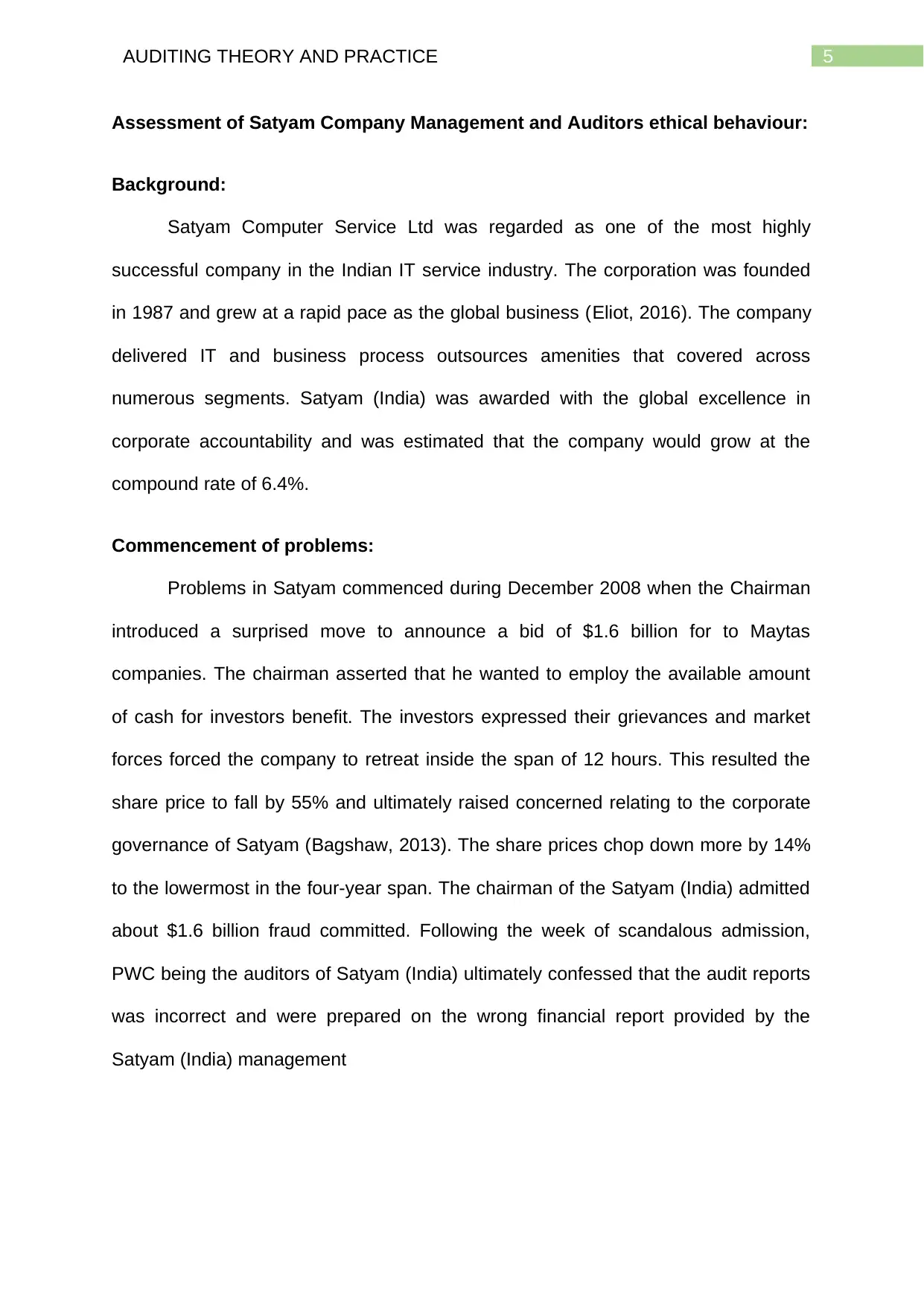
5AUDITING THEORY AND PRACTICE
Assessment of Satyam Company Management and Auditors ethical behaviour:
Background:
Satyam Computer Service Ltd was regarded as one of the most highly
successful company in the Indian IT service industry. The corporation was founded
in 1987 and grew at a rapid pace as the global business (Eliot, 2016). The company
delivered IT and business process outsources amenities that covered across
numerous segments. Satyam (India) was awarded with the global excellence in
corporate accountability and was estimated that the company would grow at the
compound rate of 6.4%.
Commencement of problems:
Problems in Satyam commenced during December 2008 when the Chairman
introduced a surprised move to announce a bid of $1.6 billion for to Maytas
companies. The chairman asserted that he wanted to employ the available amount
of cash for investors benefit. The investors expressed their grievances and market
forces forced the company to retreat inside the span of 12 hours. This resulted the
share price to fall by 55% and ultimately raised concerned relating to the corporate
governance of Satyam (Bagshaw, 2013). The share prices chop down more by 14%
to the lowermost in the four-year span. The chairman of the Satyam (India) admitted
about $1.6 billion fraud committed. Following the week of scandalous admission,
PWC being the auditors of Satyam (India) ultimately confessed that the audit reports
was incorrect and were prepared on the wrong financial report provided by the
Satyam (India) management
Assessment of Satyam Company Management and Auditors ethical behaviour:
Background:
Satyam Computer Service Ltd was regarded as one of the most highly
successful company in the Indian IT service industry. The corporation was founded
in 1987 and grew at a rapid pace as the global business (Eliot, 2016). The company
delivered IT and business process outsources amenities that covered across
numerous segments. Satyam (India) was awarded with the global excellence in
corporate accountability and was estimated that the company would grow at the
compound rate of 6.4%.
Commencement of problems:
Problems in Satyam commenced during December 2008 when the Chairman
introduced a surprised move to announce a bid of $1.6 billion for to Maytas
companies. The chairman asserted that he wanted to employ the available amount
of cash for investors benefit. The investors expressed their grievances and market
forces forced the company to retreat inside the span of 12 hours. This resulted the
share price to fall by 55% and ultimately raised concerned relating to the corporate
governance of Satyam (Bagshaw, 2013). The share prices chop down more by 14%
to the lowermost in the four-year span. The chairman of the Satyam (India) admitted
about $1.6 billion fraud committed. Following the week of scandalous admission,
PWC being the auditors of Satyam (India) ultimately confessed that the audit reports
was incorrect and were prepared on the wrong financial report provided by the
Satyam (India) management
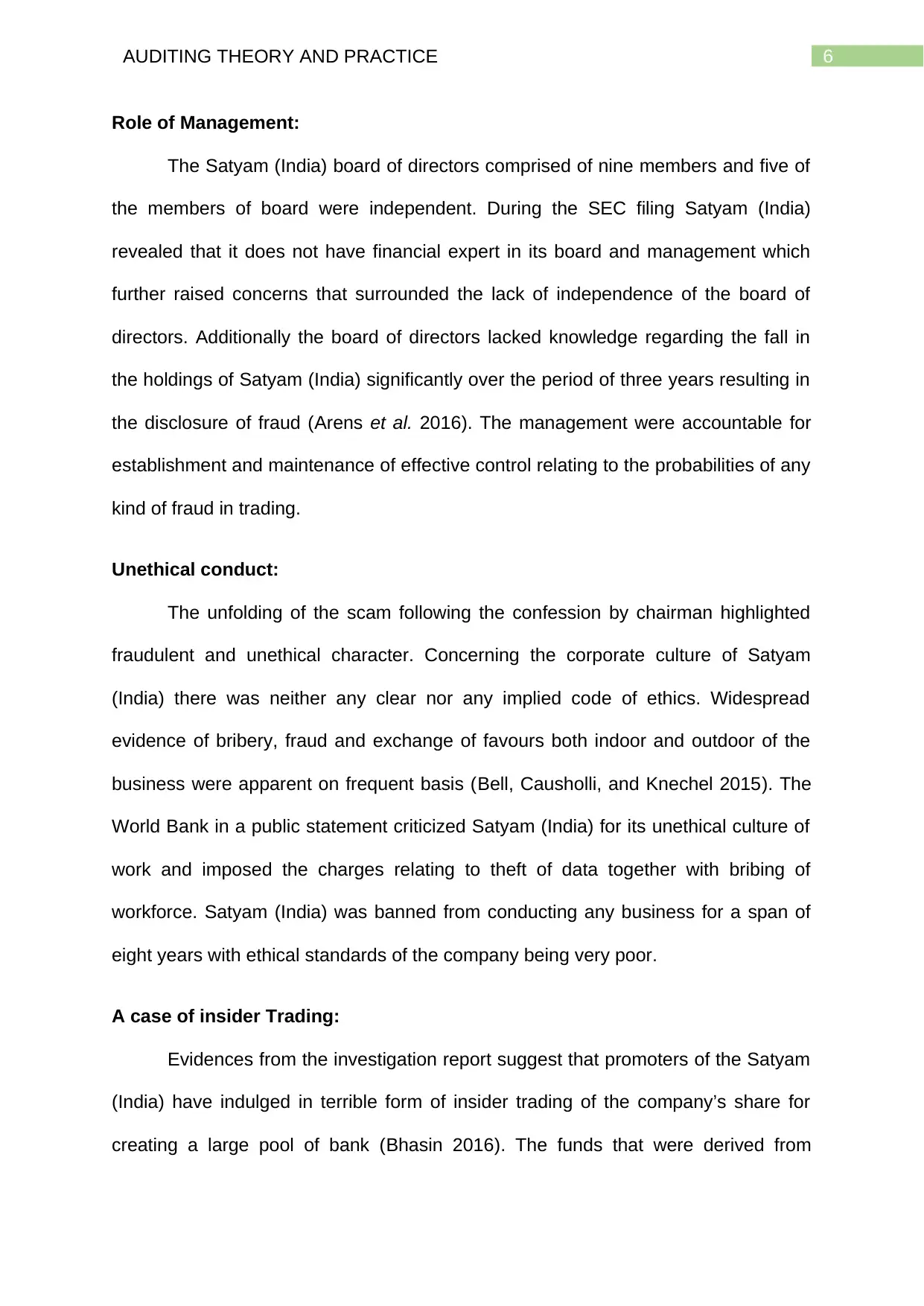
6AUDITING THEORY AND PRACTICE
Role of Management:
The Satyam (India) board of directors comprised of nine members and five of
the members of board were independent. During the SEC filing Satyam (India)
revealed that it does not have financial expert in its board and management which
further raised concerns that surrounded the lack of independence of the board of
directors. Additionally the board of directors lacked knowledge regarding the fall in
the holdings of Satyam (India) significantly over the period of three years resulting in
the disclosure of fraud (Arens et al. 2016). The management were accountable for
establishment and maintenance of effective control relating to the probabilities of any
kind of fraud in trading.
Unethical conduct:
The unfolding of the scam following the confession by chairman highlighted
fraudulent and unethical character. Concerning the corporate culture of Satyam
(India) there was neither any clear nor any implied code of ethics. Widespread
evidence of bribery, fraud and exchange of favours both indoor and outdoor of the
business were apparent on frequent basis (Bell, Causholli, and Knechel 2015). The
World Bank in a public statement criticized Satyam (India) for its unethical culture of
work and imposed the charges relating to theft of data together with bribing of
workforce. Satyam (India) was banned from conducting any business for a span of
eight years with ethical standards of the company being very poor.
A case of insider Trading:
Evidences from the investigation report suggest that promoters of the Satyam
(India) have indulged in terrible form of insider trading of the company’s share for
creating a large pool of bank (Bhasin 2016). The funds that were derived from
Role of Management:
The Satyam (India) board of directors comprised of nine members and five of
the members of board were independent. During the SEC filing Satyam (India)
revealed that it does not have financial expert in its board and management which
further raised concerns that surrounded the lack of independence of the board of
directors. Additionally the board of directors lacked knowledge regarding the fall in
the holdings of Satyam (India) significantly over the period of three years resulting in
the disclosure of fraud (Arens et al. 2016). The management were accountable for
establishment and maintenance of effective control relating to the probabilities of any
kind of fraud in trading.
Unethical conduct:
The unfolding of the scam following the confession by chairman highlighted
fraudulent and unethical character. Concerning the corporate culture of Satyam
(India) there was neither any clear nor any implied code of ethics. Widespread
evidence of bribery, fraud and exchange of favours both indoor and outdoor of the
business were apparent on frequent basis (Bell, Causholli, and Knechel 2015). The
World Bank in a public statement criticized Satyam (India) for its unethical culture of
work and imposed the charges relating to theft of data together with bribing of
workforce. Satyam (India) was banned from conducting any business for a span of
eight years with ethical standards of the company being very poor.
A case of insider Trading:
Evidences from the investigation report suggest that promoters of the Satyam
(India) have indulged in terrible form of insider trading of the company’s share for
creating a large pool of bank (Bhasin 2016). The funds that were derived from
Paraphrase This Document
Need a fresh take? Get an instant paraphrase of this document with our AI Paraphraser
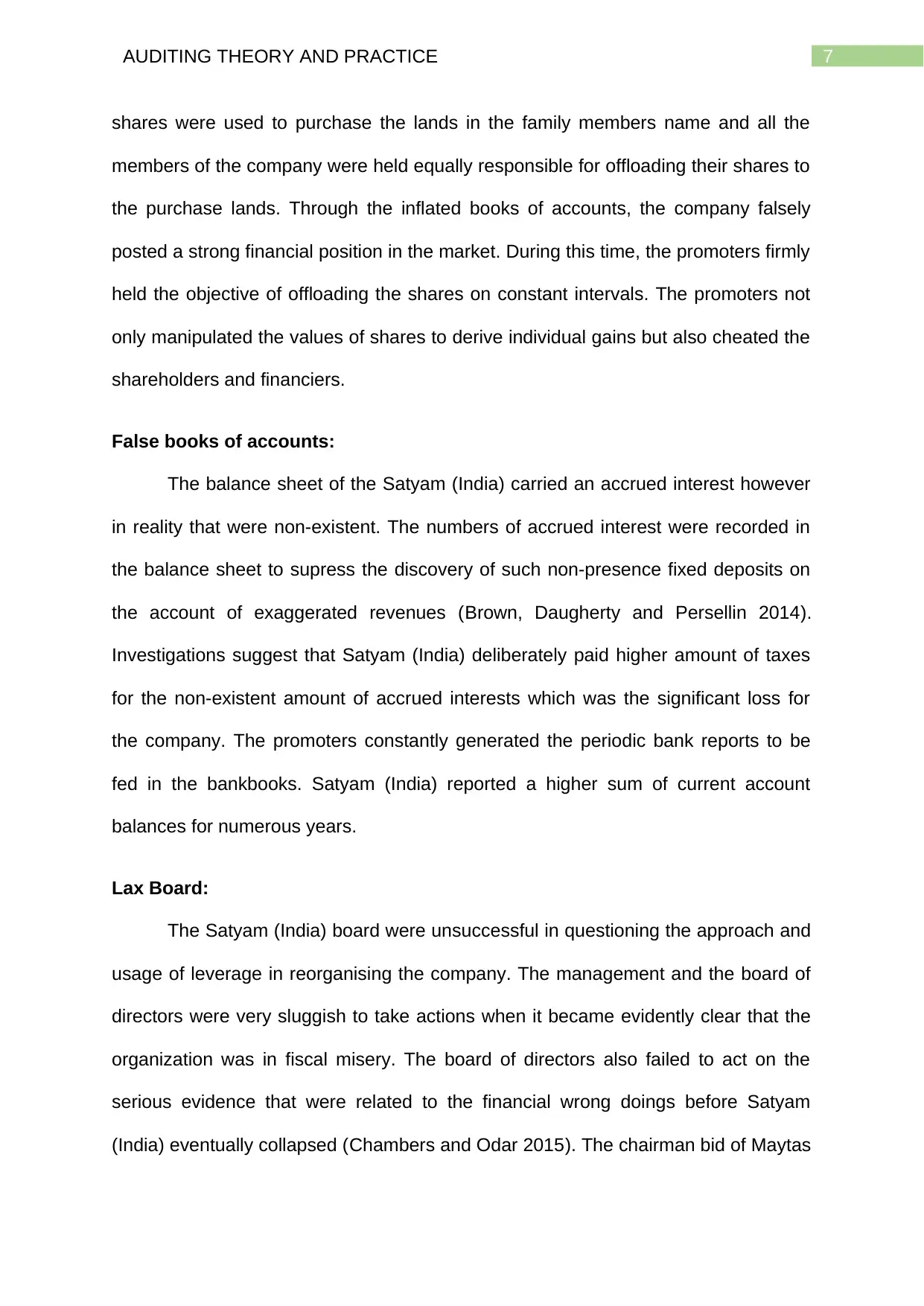
7AUDITING THEORY AND PRACTICE
shares were used to purchase the lands in the family members name and all the
members of the company were held equally responsible for offloading their shares to
the purchase lands. Through the inflated books of accounts, the company falsely
posted a strong financial position in the market. During this time, the promoters firmly
held the objective of offloading the shares on constant intervals. The promoters not
only manipulated the values of shares to derive individual gains but also cheated the
shareholders and financiers.
False books of accounts:
The balance sheet of the Satyam (India) carried an accrued interest however
in reality that were non-existent. The numbers of accrued interest were recorded in
the balance sheet to supress the discovery of such non-presence fixed deposits on
the account of exaggerated revenues (Brown, Daugherty and Persellin 2014).
Investigations suggest that Satyam (India) deliberately paid higher amount of taxes
for the non-existent amount of accrued interests which was the significant loss for
the company. The promoters constantly generated the periodic bank reports to be
fed in the bankbooks. Satyam (India) reported a higher sum of current account
balances for numerous years.
Lax Board:
The Satyam (India) board were unsuccessful in questioning the approach and
usage of leverage in reorganising the company. The management and the board of
directors were very sluggish to take actions when it became evidently clear that the
organization was in fiscal misery. The board of directors also failed to act on the
serious evidence that were related to the financial wrong doings before Satyam
(India) eventually collapsed (Chambers and Odar 2015). The chairman bid of Maytas
shares were used to purchase the lands in the family members name and all the
members of the company were held equally responsible for offloading their shares to
the purchase lands. Through the inflated books of accounts, the company falsely
posted a strong financial position in the market. During this time, the promoters firmly
held the objective of offloading the shares on constant intervals. The promoters not
only manipulated the values of shares to derive individual gains but also cheated the
shareholders and financiers.
False books of accounts:
The balance sheet of the Satyam (India) carried an accrued interest however
in reality that were non-existent. The numbers of accrued interest were recorded in
the balance sheet to supress the discovery of such non-presence fixed deposits on
the account of exaggerated revenues (Brown, Daugherty and Persellin 2014).
Investigations suggest that Satyam (India) deliberately paid higher amount of taxes
for the non-existent amount of accrued interests which was the significant loss for
the company. The promoters constantly generated the periodic bank reports to be
fed in the bankbooks. Satyam (India) reported a higher sum of current account
balances for numerous years.
Lax Board:
The Satyam (India) board were unsuccessful in questioning the approach and
usage of leverage in reorganising the company. The management and the board of
directors were very sluggish to take actions when it became evidently clear that the
organization was in fiscal misery. The board of directors also failed to act on the
serious evidence that were related to the financial wrong doings before Satyam
(India) eventually collapsed (Chambers and Odar 2015). The chairman bid of Maytas
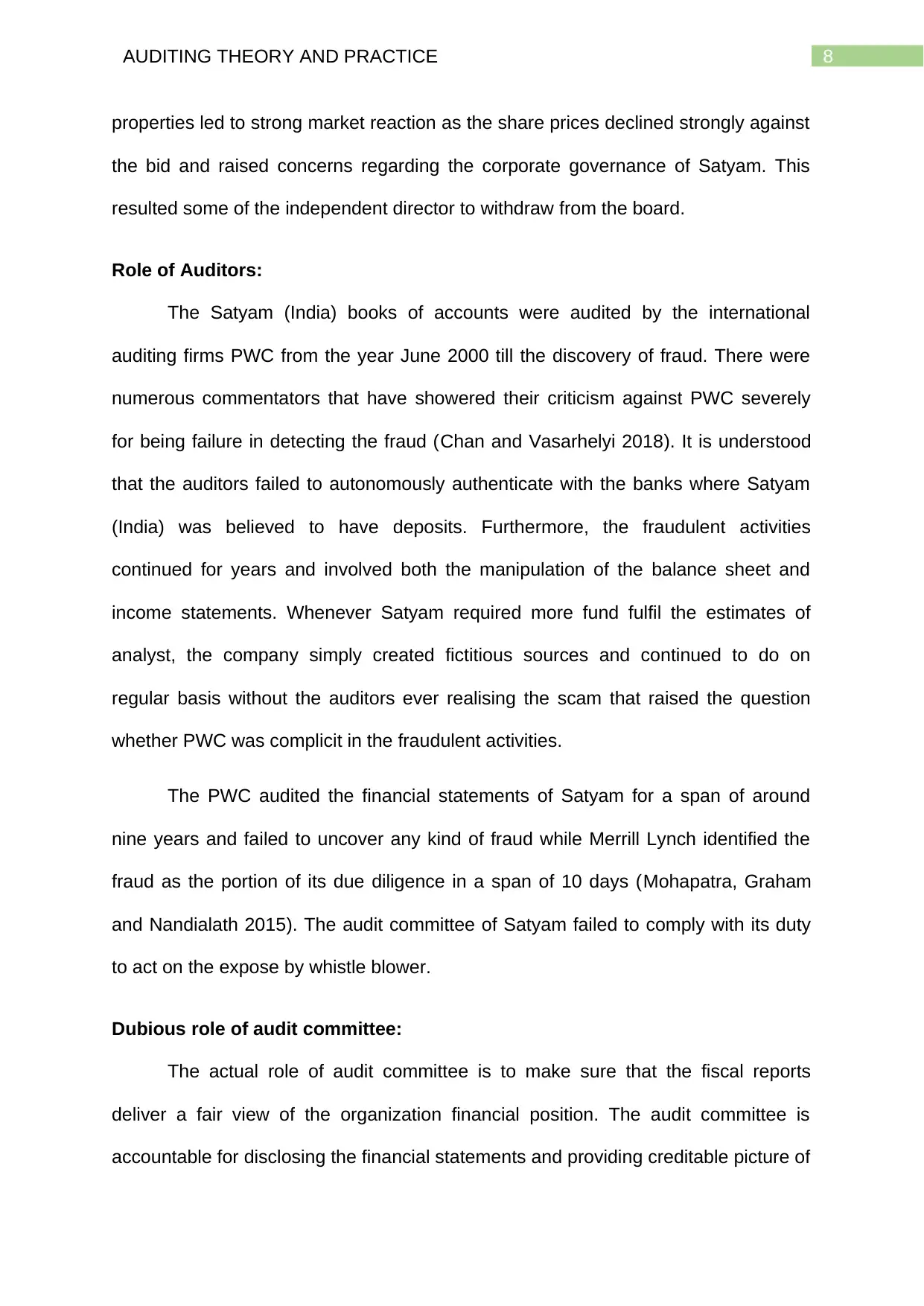
8AUDITING THEORY AND PRACTICE
properties led to strong market reaction as the share prices declined strongly against
the bid and raised concerns regarding the corporate governance of Satyam. This
resulted some of the independent director to withdraw from the board.
Role of Auditors:
The Satyam (India) books of accounts were audited by the international
auditing firms PWC from the year June 2000 till the discovery of fraud. There were
numerous commentators that have showered their criticism against PWC severely
for being failure in detecting the fraud (Chan and Vasarhelyi 2018). It is understood
that the auditors failed to autonomously authenticate with the banks where Satyam
(India) was believed to have deposits. Furthermore, the fraudulent activities
continued for years and involved both the manipulation of the balance sheet and
income statements. Whenever Satyam required more fund fulfil the estimates of
analyst, the company simply created fictitious sources and continued to do on
regular basis without the auditors ever realising the scam that raised the question
whether PWC was complicit in the fraudulent activities.
The PWC audited the financial statements of Satyam for a span of around
nine years and failed to uncover any kind of fraud while Merrill Lynch identified the
fraud as the portion of its due diligence in a span of 10 days (Mohapatra, Graham
and Nandialath 2015). The audit committee of Satyam failed to comply with its duty
to act on the expose by whistle blower.
Dubious role of audit committee:
The actual role of audit committee is to make sure that the fiscal reports
deliver a fair view of the organization financial position. The audit committee is
accountable for disclosing the financial statements and providing creditable picture of
properties led to strong market reaction as the share prices declined strongly against
the bid and raised concerns regarding the corporate governance of Satyam. This
resulted some of the independent director to withdraw from the board.
Role of Auditors:
The Satyam (India) books of accounts were audited by the international
auditing firms PWC from the year June 2000 till the discovery of fraud. There were
numerous commentators that have showered their criticism against PWC severely
for being failure in detecting the fraud (Chan and Vasarhelyi 2018). It is understood
that the auditors failed to autonomously authenticate with the banks where Satyam
(India) was believed to have deposits. Furthermore, the fraudulent activities
continued for years and involved both the manipulation of the balance sheet and
income statements. Whenever Satyam required more fund fulfil the estimates of
analyst, the company simply created fictitious sources and continued to do on
regular basis without the auditors ever realising the scam that raised the question
whether PWC was complicit in the fraudulent activities.
The PWC audited the financial statements of Satyam for a span of around
nine years and failed to uncover any kind of fraud while Merrill Lynch identified the
fraud as the portion of its due diligence in a span of 10 days (Mohapatra, Graham
and Nandialath 2015). The audit committee of Satyam failed to comply with its duty
to act on the expose by whistle blower.
Dubious role of audit committee:
The actual role of audit committee is to make sure that the fiscal reports
deliver a fair view of the organization financial position. The audit committee is
accountable for disclosing the financial statements and providing creditable picture of

9AUDITING THEORY AND PRACTICE
the organization (Mishra and Malhotra 2016). Instances of scams and
disappointment of the internal control system in the business by the audit committee
raised question on their role. Acting in time upon the receipt of info by the whistle
blower could have served as the SOS for the company however the audit committee
decided to remain silent and failed miserably to perform their duty.
Conclusion:
The case of Satyam (India) fraud has crushed the visions of shareholders,
surprised the government and resulted in enquiry of accounting practices of the
statutory auditors and governance standard. From the above mentioned wreckage
numerous corporate governance and auditing failures have been highlighted.
Though many of the corporate governance problems have been identified in the
nation such as USA, UK and European nations but these nations have strongly
reacted to the corporate failures along with the code of conduct. Similar forms of
audit reformation is required in Australia as in the words of Mr Medcraft there is a
harsh need for policy measures to prevent further unethical activity by top
management and auditors completely.
the organization (Mishra and Malhotra 2016). Instances of scams and
disappointment of the internal control system in the business by the audit committee
raised question on their role. Acting in time upon the receipt of info by the whistle
blower could have served as the SOS for the company however the audit committee
decided to remain silent and failed miserably to perform their duty.
Conclusion:
The case of Satyam (India) fraud has crushed the visions of shareholders,
surprised the government and resulted in enquiry of accounting practices of the
statutory auditors and governance standard. From the above mentioned wreckage
numerous corporate governance and auditing failures have been highlighted.
Though many of the corporate governance problems have been identified in the
nation such as USA, UK and European nations but these nations have strongly
reacted to the corporate failures along with the code of conduct. Similar forms of
audit reformation is required in Australia as in the words of Mr Medcraft there is a
harsh need for policy measures to prevent further unethical activity by top
management and auditors completely.
Secure Best Marks with AI Grader
Need help grading? Try our AI Grader for instant feedback on your assignments.
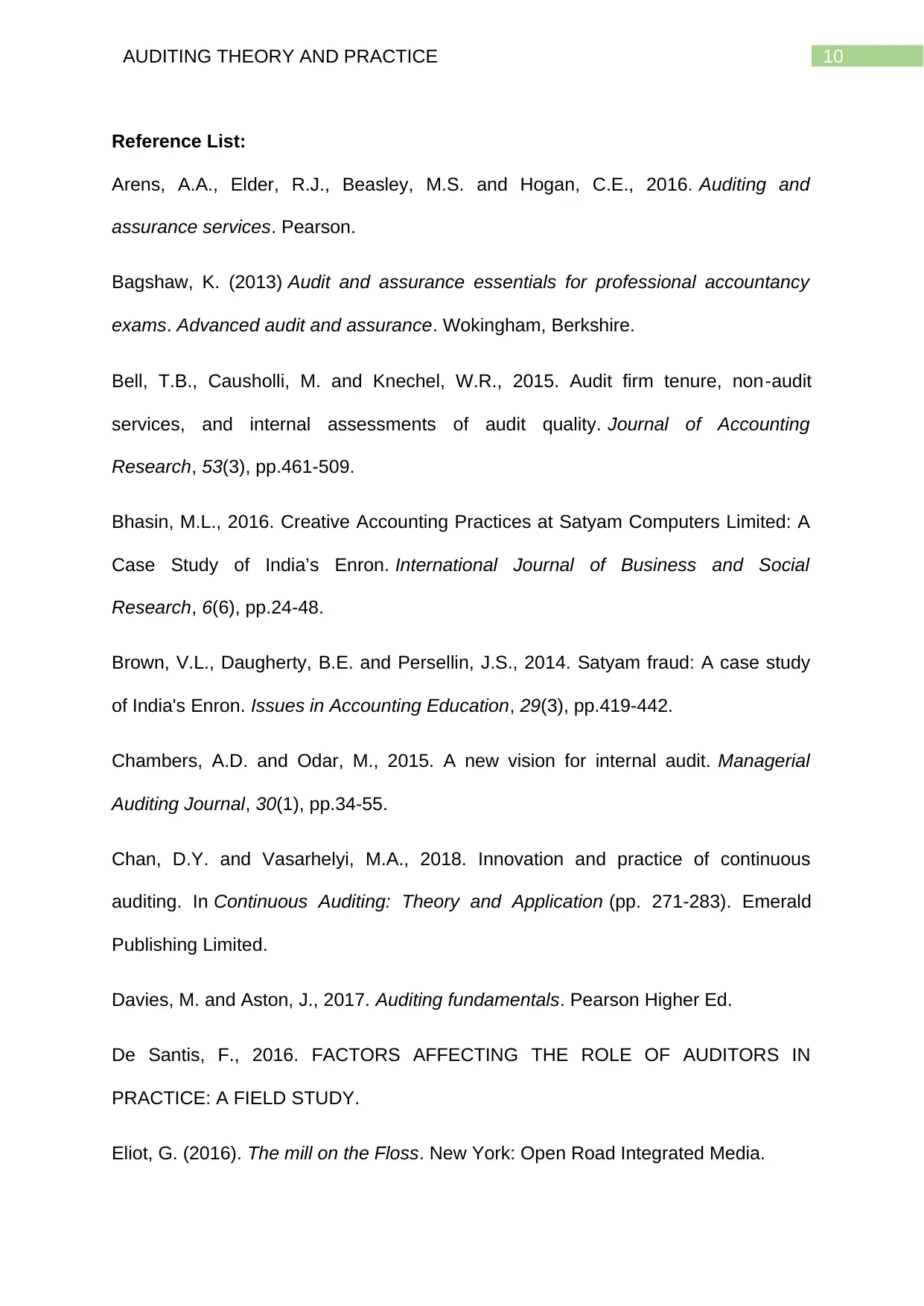
10AUDITING THEORY AND PRACTICE
Reference List:
Arens, A.A., Elder, R.J., Beasley, M.S. and Hogan, C.E., 2016. Auditing and
assurance services. Pearson.
Bagshaw, K. (2013) Audit and assurance essentials for professional accountancy
exams. Advanced audit and assurance. Wokingham, Berkshire.
Bell, T.B., Causholli, M. and Knechel, W.R., 2015. Audit firm tenure, non‐audit
services, and internal assessments of audit quality. Journal of Accounting
Research, 53(3), pp.461-509.
Bhasin, M.L., 2016. Creative Accounting Practices at Satyam Computers Limited: A
Case Study of India’s Enron. International Journal of Business and Social
Research, 6(6), pp.24-48.
Brown, V.L., Daugherty, B.E. and Persellin, J.S., 2014. Satyam fraud: A case study
of India's Enron. Issues in Accounting Education, 29(3), pp.419-442.
Chambers, A.D. and Odar, M., 2015. A new vision for internal audit. Managerial
Auditing Journal, 30(1), pp.34-55.
Chan, D.Y. and Vasarhelyi, M.A., 2018. Innovation and practice of continuous
auditing. In Continuous Auditing: Theory and Application (pp. 271-283). Emerald
Publishing Limited.
Davies, M. and Aston, J., 2017. Auditing fundamentals. Pearson Higher Ed.
De Santis, F., 2016. FACTORS AFFECTING THE ROLE OF AUDITORS IN
PRACTICE: A FIELD STUDY.
Eliot, G. (2016). The mill on the Floss. New York: Open Road Integrated Media.
Reference List:
Arens, A.A., Elder, R.J., Beasley, M.S. and Hogan, C.E., 2016. Auditing and
assurance services. Pearson.
Bagshaw, K. (2013) Audit and assurance essentials for professional accountancy
exams. Advanced audit and assurance. Wokingham, Berkshire.
Bell, T.B., Causholli, M. and Knechel, W.R., 2015. Audit firm tenure, non‐audit
services, and internal assessments of audit quality. Journal of Accounting
Research, 53(3), pp.461-509.
Bhasin, M.L., 2016. Creative Accounting Practices at Satyam Computers Limited: A
Case Study of India’s Enron. International Journal of Business and Social
Research, 6(6), pp.24-48.
Brown, V.L., Daugherty, B.E. and Persellin, J.S., 2014. Satyam fraud: A case study
of India's Enron. Issues in Accounting Education, 29(3), pp.419-442.
Chambers, A.D. and Odar, M., 2015. A new vision for internal audit. Managerial
Auditing Journal, 30(1), pp.34-55.
Chan, D.Y. and Vasarhelyi, M.A., 2018. Innovation and practice of continuous
auditing. In Continuous Auditing: Theory and Application (pp. 271-283). Emerald
Publishing Limited.
Davies, M. and Aston, J., 2017. Auditing fundamentals. Pearson Higher Ed.
De Santis, F., 2016. FACTORS AFFECTING THE ROLE OF AUDITORS IN
PRACTICE: A FIELD STUDY.
Eliot, G. (2016). The mill on the Floss. New York: Open Road Integrated Media.
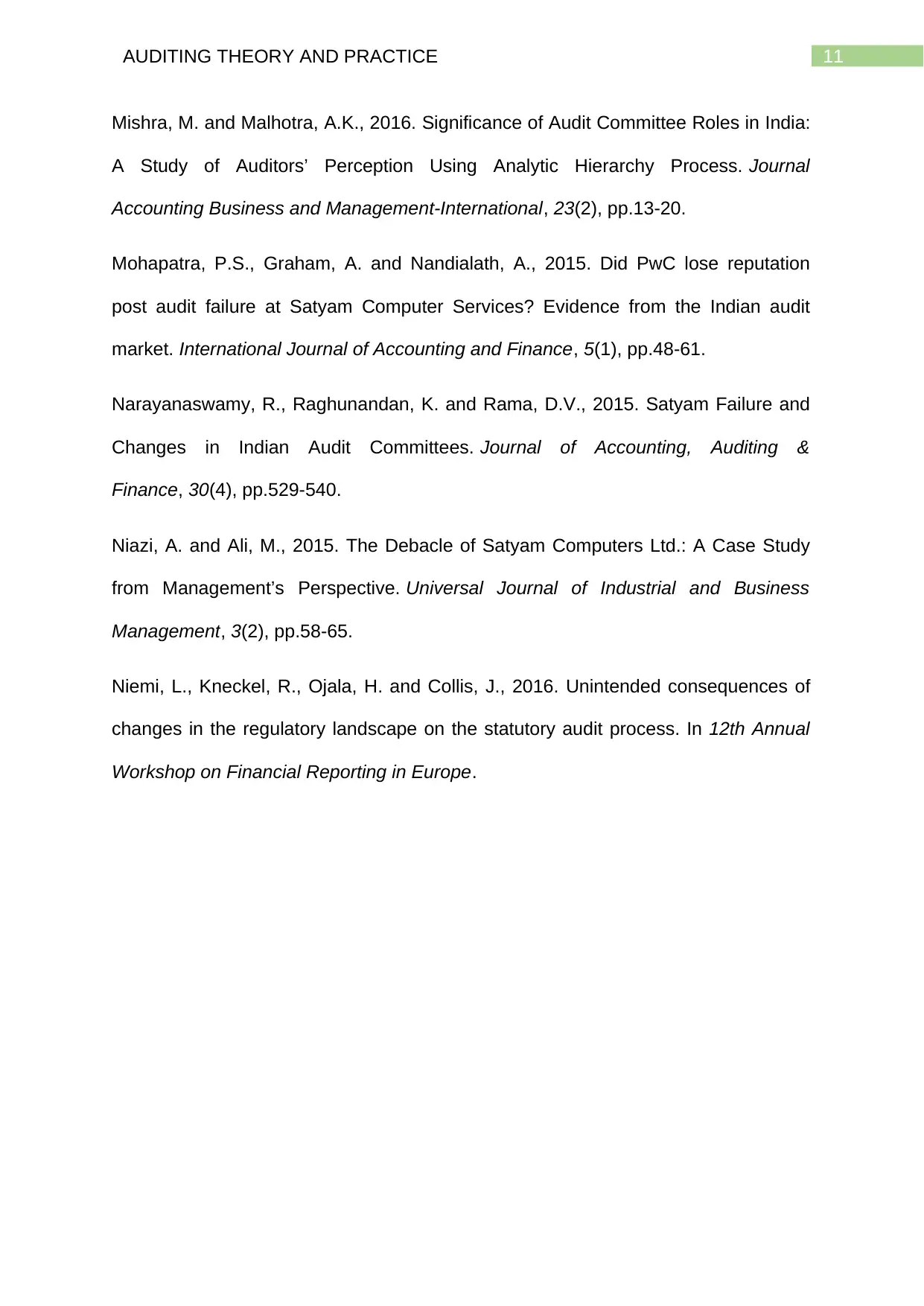
11AUDITING THEORY AND PRACTICE
Mishra, M. and Malhotra, A.K., 2016. Significance of Audit Committee Roles in India:
A Study of Auditors’ Perception Using Analytic Hierarchy Process. Journal
Accounting Business and Management-International, 23(2), pp.13-20.
Mohapatra, P.S., Graham, A. and Nandialath, A., 2015. Did PwC lose reputation
post audit failure at Satyam Computer Services? Evidence from the Indian audit
market. International Journal of Accounting and Finance, 5(1), pp.48-61.
Narayanaswamy, R., Raghunandan, K. and Rama, D.V., 2015. Satyam Failure and
Changes in Indian Audit Committees. Journal of Accounting, Auditing &
Finance, 30(4), pp.529-540.
Niazi, A. and Ali, M., 2015. The Debacle of Satyam Computers Ltd.: A Case Study
from Management’s Perspective. Universal Journal of Industrial and Business
Management, 3(2), pp.58-65.
Niemi, L., Kneckel, R., Ojala, H. and Collis, J., 2016. Unintended consequences of
changes in the regulatory landscape on the statutory audit process. In 12th Annual
Workshop on Financial Reporting in Europe.
Mishra, M. and Malhotra, A.K., 2016. Significance of Audit Committee Roles in India:
A Study of Auditors’ Perception Using Analytic Hierarchy Process. Journal
Accounting Business and Management-International, 23(2), pp.13-20.
Mohapatra, P.S., Graham, A. and Nandialath, A., 2015. Did PwC lose reputation
post audit failure at Satyam Computer Services? Evidence from the Indian audit
market. International Journal of Accounting and Finance, 5(1), pp.48-61.
Narayanaswamy, R., Raghunandan, K. and Rama, D.V., 2015. Satyam Failure and
Changes in Indian Audit Committees. Journal of Accounting, Auditing &
Finance, 30(4), pp.529-540.
Niazi, A. and Ali, M., 2015. The Debacle of Satyam Computers Ltd.: A Case Study
from Management’s Perspective. Universal Journal of Industrial and Business
Management, 3(2), pp.58-65.
Niemi, L., Kneckel, R., Ojala, H. and Collis, J., 2016. Unintended consequences of
changes in the regulatory landscape on the statutory audit process. In 12th Annual
Workshop on Financial Reporting in Europe.
1 out of 12
Related Documents
Your All-in-One AI-Powered Toolkit for Academic Success.
+13062052269
info@desklib.com
Available 24*7 on WhatsApp / Email
![[object Object]](/_next/static/media/star-bottom.7253800d.svg)
Unlock your academic potential
© 2024 | Zucol Services PVT LTD | All rights reserved.





